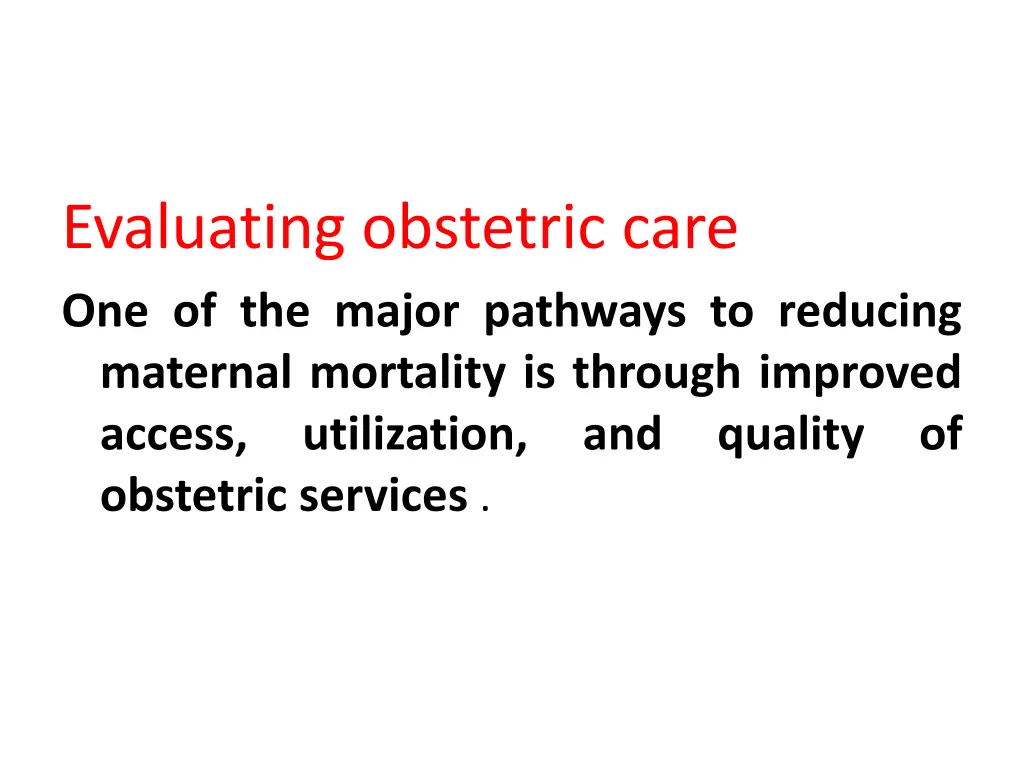
Improving Obstetric Care for Maternal Health
Enhancing access and quality of obstetric services is crucial to reduce maternal mortality. Learn about key indicators and guidelines from UNICEF, WHO, and UNFPA for evaluating obstetric care and ensuring adequate medical care for pregnant women.
Download Presentation

Please find below an Image/Link to download the presentation.
The content on the website is provided AS IS for your information and personal use only. It may not be sold, licensed, or shared on other websites without obtaining consent from the author. If you encounter any issues during the download, it is possible that the publisher has removed the file from their server.
You are allowed to download the files provided on this website for personal or commercial use, subject to the condition that they are used lawfully. All files are the property of their respective owners.
The content on the website is provided AS IS for your information and personal use only. It may not be sold, licensed, or shared on other websites without obtaining consent from the author.
E N D
Presentation Transcript
Evaluating obstetric care One of the major pathways to reducing maternal mortality is through improved access, utilization, obstetric services . and quality of
The UNICEF, WHO, and UNFPA have developed a series of process specifically on these issues, designed for use by policy and programme planners. indicators that focus
The indicators use data that can be collected and analyzed at the health facility level and do not require large-scale population-based enquiries
The following is a list of these indicators: 1-Essential obstetric care coverage a-Amount of EOC services A number of authors have estimated the proportion of pregnant women who develop serious complications to be at least 15%
Furthermore, a technical working group assembled by the WHO agreed to use 15% as the minimum proportion of pregnant women who require medical care in order to avoid death or disability
Furthermore, a technical working group assembled by the WHO agreed to use 15% as the minimum proportion of pregnant women who require medical care in order to avoid death or disability
The number of EOC facilities which are required to treat complications depends on the size and capabilities of the facilities. One could count only facilities where all of the EOC procedures are performed, this would, however, impose an unnecessarily strict standard.
The number of EOC facilities which are required to treat complications depends on the size and capabilities of the facilities. One could count only facilities where all of the EOC procedures are performed, this would, however, impose an unnecessarily strict standard.
Moreover, it would import the wrong message by implying that only hospitals are useful in reducing maternal mortality.
Moreover, it would import the wrong message by implying that only hospitals are useful in reducing maternal mortality.
It is this mistaken impression that has given some policy makers the idea that reducing maternal deaths means building new hospitals and supplying them with sophisticated equipment and specialist physicians.
This is not necessary in many places. In fact, one of the most promising interventions is the upgrading of health centers and other small facilities so that they can provide basic EOC.
It is important that the distinction be made on the basis of how facilities are actually functioning and not on how they are supposed to function..
In order to assess which level of care an EOC facility is actually providing, it is helpful to select a few important EOC functions to identify both basic and comprehensive EOC.
In order to assess which level of care an EOC facility is actually providing, it is helpful to select a few important EOC functions to identify both basic and comprehensive EOC.
Basic EOC services 1-Administer parenteral antibiotics2-Administer parenteral oxytocin drugs3-Administer parenteral anticonvulsants for pre-eclampsia and eclampsia
4-Perform manual removal of the placenta5-Perform removal of retained products (e.g. manual vacuum aspiration)6-Perform assisted vaginal delivery
Comprehensive EOC services1-6 All of those included in basic EOC 7-Perform surgery (Caesarean section)8-Perform blood transfusion
-A basic EOC facility is one that is performing all functions of 1-6 -A comprehensive EOC facility is one that is performing all functions 1-8
-A basic EOC facility is one that is performing all functions of 1-6 -A comprehensive EOC facility is one that is performing all functions 1-8
The minimum acceptable level of this indicator (amount of EOC) has been defined in relation to population rather than births because most health planning is done in relation to population
(for every 500000 people, there should be: 1 facility providing comprehensive EOC, and 4 facilities providing basic EOC) .
(for every 500000 people, there should be: 1 facility providing comprehensive EOC, and 4 facilities providing basic EOC) .
(for every 500000 people, there should be: 1 facility providing comprehensive EOC, and 4 facilities providing basic EOC) .
b-Geographical distribution of EOC facilities A telling indicator of access to EOC is time. Time is crucial to the survival of women with complications.
for most complications the average time is 12 hours or more. The exception to this is postpartum haemorrhage, which can kill a woman in less than one hour. Haemorrhage, is however, one of the few major obstetric complications for which first aid could be provided at peripheral health facilities
Statistically, it divides the population within one hour travel time (by whatever means of transport are generally used) of a health centre providing obstetric care in a specific area by the total population in the same area
c-Proportion of all births in basic and comprehensive EOC facilities The proportion of all births that take place in EOC facility serves as a crude indicator of utilization of EOC facilities
. It is estimated that 15% of pregnant women develop an obstetric complication serious enough to require medical care.
. It is estimated that 15% of pregnant women develop an obstetric complication serious enough to require medical care.
Thus, if the number of women receiving care in an EOC facility is not at least 15% of all women giving birth in the population, then it is certain that some proportion of obstetric complications are going untreated.
In that case, the efforts of the national maternal care programme should be directed towards seeing why the existing facilities are not being utilized by women who need medical care
d-Met need for EOC: Proportion of all women with complications who are treated in EOC facilities Of course, just because 15% of births take place in EOC facilities does not mean that women with complications are receiving care.
It might be that most of the births in the EOC facilities are normal deliveries. In that case, the women with complications would still be outside the EOC facilities and not receiving treatment..
This indicator, therefore, is a more refined measure of the utilization of EOC services because it takes into account the type of activities occurring in the EOC facilities
e-Caesarean sections as a proportion of all births Caesarean sections are life-saving procedures, part of the essential obstetric care functions, particularly important for cases of obstructed labour.
The indicator divides the total number of all direct obstetric deaths within one facility during a specific period of time by all direct complications in the same facility during the same period
. It was found that there is a wide gulf between case fatality rates in developed countries and those in developing countries.
Deaths among women with complications in West African hospitals in the late 1980s ranged from a low of 1.2% in Kumasi, Ghana, to a high of 8% in Ota, Nigeria
Deaths among women with complications in West African hospitals in the late 1980s ranged from a low of 1.2% in Kumasi, Ghana, to a high of 8% in Ota, Nigeria
TO SUMMARIZE THE EOC INDICATORS
every 500,00 population, there should be : At least 4 basic EOC facilities and 1 comprehensive EOC facility
of all births in basic and comprehensive EOC facilities .At least 15% of all births in the population take place in either basic or comprehensive EOC
Met need for EOC : -At least 100% of women estimated to have obstetric complications are treated in EOC facilities
Case fatality rate.The case fatality rate among women with obstetric complications in EOC facilities is less than 1%
Proportion of births attended by skilled health personnel, -Proportion of pregnant women attending antenatal care, -Proportion of pregnant women receiving tetanus toxoid immunization, -Proportion of births taking place in health institutions.
Other widely-used tools to asses and monitor the quality of maternal health services are maternal death case review and facility-based audits. A maternal death case review is a qualitative in-depth investigation of the causes and circumstances surrounding a small number of maternal deaths occurring at selected health facilities. A team of people (generally composed of staff from the facility) is established to conduct the review.
Another method for collection of information on maternal deaths is verbal autopsies, in which information is collected from lay reporters and relatives to establish the cause of death, data are not collected from health facilities






















